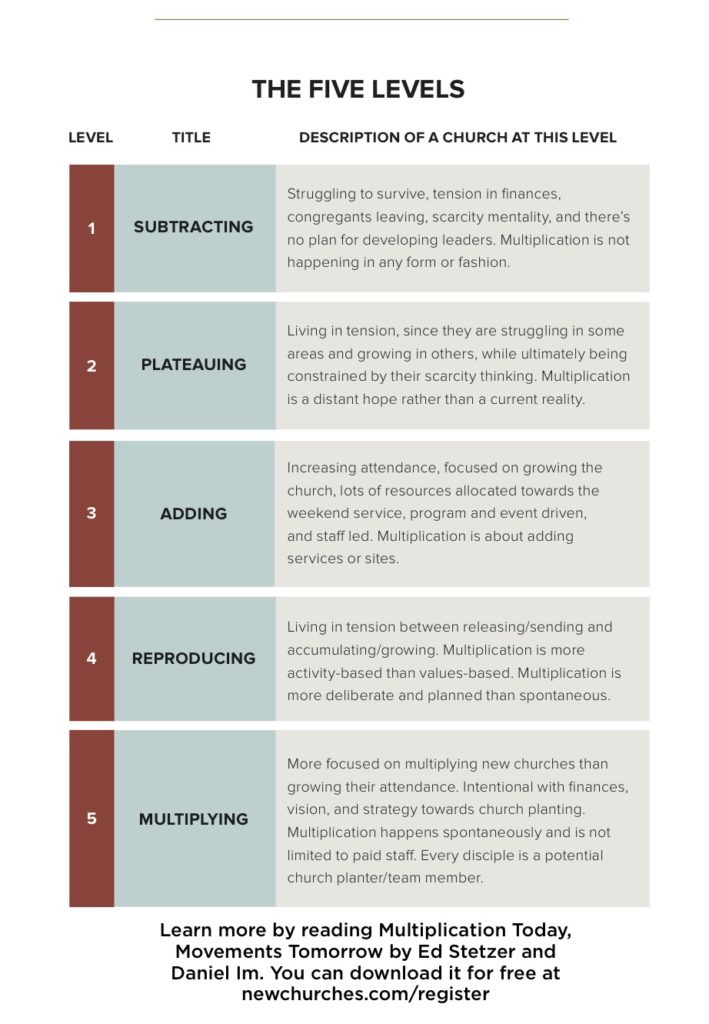In every story and aspect of life, there always seem to be opposing forces.
On our planet, you have night and day. In Romeo and Juliet, you have the Capulets and the Montagues. In Star Wars, you have the Rebellion and the Empire. In Marvel, you have the Agents of S.H.I.E.L.D. and Hydra. And in life, you have the close talkers, who don’t know what a breath mint is (Seinfeld anyone?), and everyone else, who seems to have a good handle on personal space and emotional intelligence.
In the same way, we see similar forces when it comes to church multiplication. There are characteristics that lead to multiplication, as well as factors that prevent multiplication. In the same way, there are characteristics that can lead your church to becoming a Level Five church, as well as factors that will prevent that and stall you at Level Two or Three (see below for a chart of the various levels).
In this article, we will examine barriers that prevent a church from multiplying:
1. Fear
Church planters would do well to heed Paul’s exhortation to Timothy,
…for God gave us a spirit not of fear but of power and love and self-control (2 Tim. 1:7).
Paul knew that fear of anything other than a healthy reverent fear of the glory and sovereignty of God would prevent believers from fulfilling the call of God. Even Marie Curie, a scientist who won the Nobel Prize multiple times, understood the paralyzing power of fear, which is why she noted, “Nothing in life is to be feared. It is only to be understood.”
The reality is that the fear of the unknown, of losing friends, of losing tithers, of change, and of failure are all factors that prevent churches from multiplying. For example, fear often drives churches to soothe their growing pains by starting another campus, instead of planting another church.
Now don’t get me wrong, I am for multisite, but only when it’s a strategy that comes alongside church planting. For many churches ridden with fear, they never plant a church because they’re afraid it won’t succeed. Multisite needs to be seen as an alternative for building a bigger building, rather than as a replacement for church planting.
Also, fear of people’s murmurs and spats of complaining about planting another church paralyzes leaders (and thus churches) from taking the leap of faith.
Some of your people may wonder why you’re talking about planting another church when you haven’t even broken the 200 barrier, as if a church has to be running over 200 to plant another church. But if you probed deeper, you would find that the murmurs and complaints are coming from a fear of losing friends or even losing control.
If these fears are not understood and addressed on a global scale, and in every ministry and system within the church, then your church will never be able to multiply. Vaneetha Rendall reflects on three Hebrews in exile (Shadrach, Meshach, and Abednego) and offers cogent counsel to those of us who find ourselves vacillating between fear and obedience. She states,
Even if the worst happens, God’s grace is sufficient. Those three young men faced the fire without fear because they knew that whatever the outcome, it would ultimately be for their good and for God’s glory. They did not ask “what if” the worst happened. They were satisfied knowing that “even if” the worst happened, God would take care of them. Even if. Those two simple words have taken the fear out of life.
Replacing “what if” with “even if” is one of the most liberating exchanges we can ever make. We trade our irrational fears of an uncertain future for the loving assurance of an unchanging God. We see that even if the worst happens, God will carry us. He will still be good. And He will never leave us.
One of the easiest ways to gauge whether or not the fear of multiplication is present within your church is to talk to your small group leaders about multiplication. Ask them if they (or their group) are open to multiplying themselves. If they resist and balk at the idea, then you know that there’s a greater measure of fear than faith towards multiplication in your church.
2. Perceived and Actual Scarcity
“What’s the right size to multiply your church?”
There’s a rumor out there that goes like this: “It’s 25% larger than your current church. So if your church is currently at 100 people, then it’s when you’re 125; or if you’re 1,000, then it’s when you’re attendance is at 1,250.” The problem with this “statistic” is that it’s driven by a perceived scarcity mindset, which will ultimately keep your church from multiplying.
Let me explain. This mindset says that you cannot multiply until you have enough leaders to fill the potential vacancies, or until you have more than enough tithers to replace those who are leaving. If this is your mindset, then you’ll never have enough to reach that 25% mark because there’ll always be more needs and additional ministry to do.
The opposite of a perceived scarcity mindset is an abundant mentality.
So instead of thinking that you’ll lose band members or small-group leaders when you multiply, you need to understand that others will step up and fill those vacancies when those leaders leave. We’ve seen this happen time after time.
There is a difference between perceived and actual scarcity, however. For example, there are times and seasons when planting another church would not be wise. This could be three months after your church launched if your church is going through a split, or if there’s been a scandal or a moral failure in your church.
During these moments, there is an actual scarcity of trust, resources, and people. But for the majority of churches, it is perceived scarcity that prevents them from multiplying. We would do well to remember Hudson Taylor’s words: “God’s work done in God’s way will never lack God’s supply.”
3. Bad Math
There’s a myth going around where some think that it’s a more effective use of time, resources, and energy to just add people to your church, rather than expend the energy to plant a whole new church. This is problematic.
In fact, it doesn’t make any sense numerically. When you plant churches that multiply and plant other churches, that plant other churches, you will reach a far greater number of people than if your church were to just add seats and services. Furthermore, we have discovered that new churches have a higher likelihood of making an impact and are more successful at reaching new people than existing churches.
So let’s do good math—addition is fine, but multiplication is better. John Mark Terry and J. D. Payne speak to this reality in Developing A Strategy For Missions (2013):
The Church Growth Movement has always contended that church planting is the key to fulfilling the Great Commission (Matt. 28:18-20). The first century Christians obeyed Jesus’ command by planting churches all over the Roman Empire. Church growth research has demonstrated that new churches are more evangelistic than older churches and more active in church planting.
In other words, new units multiply more rapidly than older units. It is easy to see why the Church Growth Movement advocated aggressive church planting.
4. Church Centricity
One of the greatest temptations for pastors and churches is over focusing on your church at the expense of church planting.
I understand this temptation. The truth is, there will always be needs and ministry opportunities at your church.
You will always be tempted to purchase a building before planting another church—especially if you’re portable.
Members will always be lined up outside your office for counsel, although your time may be better spent developing leaders who could counsel those church members.
In church life, as in personal life, there’s always the temptation to spend the extra time, money, and resources on ourselves rather than investing them in others. Thus, church centricity is the antithesis to the first characteristic of a multiplying church, which is outlined in the book that this entire article is excerpted from: Multiplication Today, Movements Tomorrow: Practices, Barriers, and an Ecosystem. (You can download the e-version of this book for free here).
We must overcome the church centricity barrier by moving from an ‘inward focus’ to an ‘outward focus.’ So, what does a church with an ‘outward focus’ look like?
In the LifeWay research on transformational churches, churches that met our criteria as a transformational church had 67% of members agree that, “Our church leaders think as missionaries and work to understand the cultural context in our region.”[i]
In addition, 71% believed, “Our leadership senses a call to our local city or community”[ii] and 77% said, “Our church leadership understands the context.”[iii]
Such beliefs and behaviors display an outward focus. By having such a mentality, churches seem to embrace a Christ-centered, gospel-centered mindset—where they love God and others—which propels them to become a church that is mission- oriented and multiplication bound.
Next week, in Part 2 of this series, we will look at the next four barriers to multiplication.
If you want to learn the characteristics of churches that multiply, and the research that all of this is based upon, go here to download the entire book that this article is excerpted from.

Endnotes:
[i] Ed Stetzer and Thom Rainer, Transformational Church: Creating a New Scorecard for Congregations (Nashville: B&H Publishing, 2010), 53.
[ii] Ibid, 50.
[iii] Ibid, 59.
*My post here was originally published on Sep 7, 2016 in Christianity Today.
